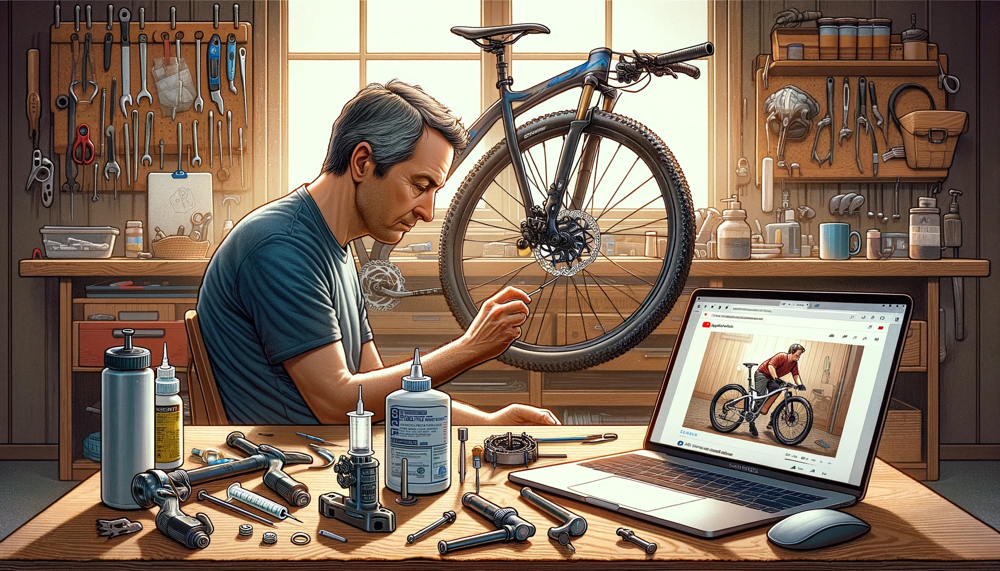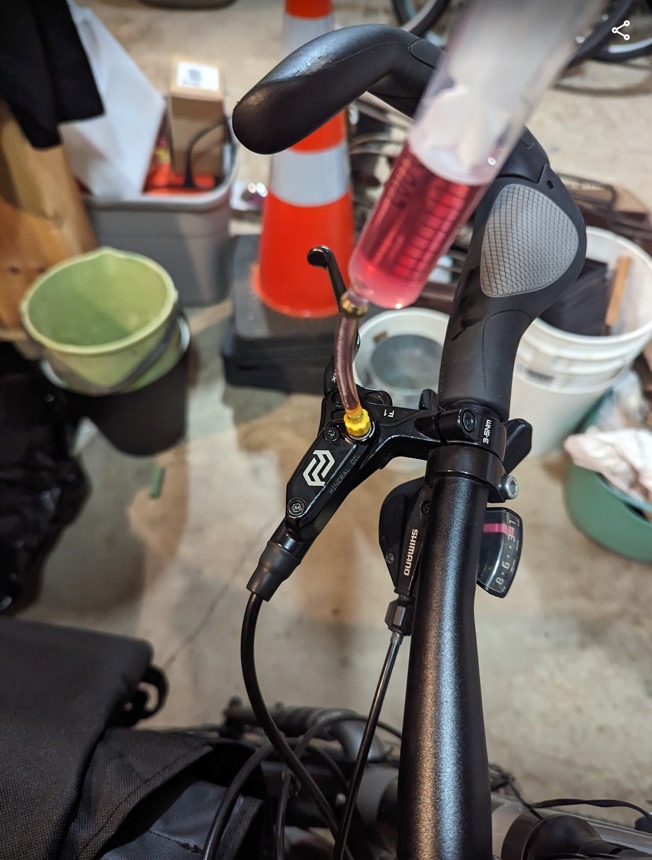Bleeding my brakes (ZAMM series)
Introduction
During the weekend I decided to try another experiment with intuitive thinking: bleeding my brakes. Earlier I noted that while fixing my stuck wheel, I’d unscrewed something on my rear brake caliper, and the brake went slack, not providing any tension. I resented having to learn hydraulic brakes given that I already knew how to adjust rim brakes and didn’t see any noticeable improvement in braking between rim and hydraulic brakes. Hydraulic brakes just seemed like a way to sell higher-end, more expensive bikes.
I also knew that I couldn’t take my bike into the shop to have them fix it after reading ZAMM. I stewed over this task for about a week before finally having some time to make an attempt.
I know that Pirsig’s narrator argues against having a rational method of steps to follow, but perhaps some broad strokes are okay. Here’s what I did.
Getting peace of mind
The first step toward approaching problems intuitively, from my reading of Pirsig’s Zen and the Art of Motorcycle Maintenance, is to cultivate the right peace of mind. To cultivate that peace of mind, I needed to develop a sense of mindfulness to recognize my inner emotional state. If I wasn’t in a peace-of-mind state before tackling the task, I needed to get into this state. Once in that state, I’d be relaxed and open enough to proceed more intuitively rather than rigidly.
I downloaded the Calm app (the meditation app I’d previously used but abandoned) and listened to the current day’s guided meditation for 10 minutes. During this session, the instructor gently guides you to concentrate solely on your breathing for approximately 6 to 7 minutes, accompanied by calming background music. The goal is to focus exclusively on the inhalation and exhalation of your breath, letting go of all other thoughts. After this period of focused breathing, the instructor briefly introduces a thoughtful lesson for a minute or two. The session then circles back to a final phase of focused breathing before concluding.
The lesson she taught was an interesting one. Normally it’s somewhat cheesy, but this one seemed to align with so much of what I’m writing here. She retold a classic Taoist parable of a man who falls into a raging river that goes off a small cliff. Onlookers passing by are concerned that the man drowns, but when they look at the bottom of the water dropoff, they see the man standing unharmed on the bank below. They ask him how he survived, and he says that instead of fighting against the water, he submitted to the ebb and flow of the water and let it take him. The point is to illustrate effortless action, a key Taoist idea. Basically, you go with the natural flow of things rather than fighting against that natural flow.

This is a topic I’ll return to later in this series, I think. For now, let me continue with the brake bleed. I’m not great at following these meditations. My monkey mind tends to wander, and I have to frequently pull my focus back to breathing. But it sort of does enough to induce a peaceful state of mind. If my stress level is a 4/10 naturally, the calm meditation pulls me back to 2/10.
Learning and doing
With this peace of mind, I started watching some YouTube videos to learn how hydraulic brakes work at a high level. I learned that pulling the brake exerts pressure in the brake line, forcing the fluid to push the pistons and their pads against the spinning rim. Then I proceeded to watch some other brake-related videos.
Different videos showed conflicting techniques about the process for bleeding brakes — the process varies based on the kinds of brakes you have, the type of fluid, and your brake kit. After watching some videos, the easiest approach was a gravity bleed with the brake cup, so I went out to the garage and did that.
First, however, I bled the wrong brake. I bled the front one instead of the back. But rather than get frustrated, I proceeded somewhat patiently, telling myself this was good practice. Then I proceeded to bleed the rear brake. I saw a few air bubbles come out, but not much, and my brake was still slack. The gravity bleed didn’t work.
So I returned to my computer and watched some more videos. The brake bleed kit I ordered came with an overwhelming number of parts, adapters, syringes, and such. I decided to learn how to bleed brakes using the syringe method, and so asked ChatGPT for some info as well as watched some videos.

Then I returned to my bike, attached a syringe onto the rear brake and tried to force fluid into the brake line as I pumped the brake. I could feel the brake take on resistance when pushing fluid with the syringe, and I started to get excited that it might be fixed. But as soon as I unhooked the syringe, the brake no longer had any resistance when I squeezed it.

Rather than feeling upset and defeated, I still had a kind of calmness inside me. The initial peace of mind was like an ember that continued to glow instead of fizzle out. I returned to my computer and watched some more YouTube videos, then asked more questions to ChatGPT. After learning more about the syringe technique, I realized that I needed to hook up one syringe to my brake caliper and another to my brake bleed screw and transfer fluid through the system that way, pushing out the air. This would require me to remove my brake caliper and pads, and then somehow push one syringe while pulling the other at the same time. I watched some more videos showing the technique.
I returned to my bike and deliberated about whether to continue trying to bleed my brakes, as it was already 9pm and I’d spent 2 hours already working on this and was tired. I decided to keep going.
I flipped my bike over, removed the back rim, and then looked around to see how to remove my brake caliper. I undid 2 screws. I was about to pull the clip out but then realized I didn’t know how to get the pin out, so I returned to my computer to rewatch some videos on this. I hadn’t realized that I’d need to bend the clip with pliers to remove it.
At this point, I was tired and decided to call it a day. I reattached my brake caliper to my bike, then reattached the wheel (it didn’t easily go back on, and I had to sort of pry open the back forks to give the axel the needed clearance). Then I wiped up the mineral oil near my tools and put things away. I decided that I’d resume working on this problem again during the Thanksgiving break. I could live without a back brake for another week.
Even though I didn’t fix it, I was surprised by my patience and my efforts to keep learning and trying things. Normally, I might have given up quickly, or grown frustrated, especially when I started bleeding the wrong brake, or when the oil spilled out of the syringe, or when it wasn’t clear which adapter I needed to use or how the syringe technique worked. But like I said, the peace of mind I’d cultivated at the start continued to grow like a warm ember in my chest, and somehow I maintained patience and persistence.
Even though I hadn’t fixed the brake, the ability to continue working towards a problem, persistently and patiently, must be a key trait for success, I felt. Eventually, if I kept learning and trying and learning and trying, at some point, I would probably have success. Brake bleeds aren’t rocket science. What’s hard is cultivating the attitude to do this, without tapping out and going to watch sports or TV instead.
This brings me to another key point: removing deadline pressure.
Continue to the next post, The importance of using the right tools.
About Tom Johnson

I'm an API technical writer based in the Seattle area. On this blog, I write about topics related to technical writing and communication — such as software documentation, API documentation, AI, information architecture, content strategy, writing processes, plain language, tech comm careers, and more. Check out my API documentation course if you're looking for more info about documenting APIs. Or see my posts on AI and AI course section for more on the latest in AI and tech comm.
If you're a technical writer and want to keep on top of the latest trends in the tech comm, be sure to subscribe to email updates below. You can also learn more about me or contact me. Finally, note that the opinions I express on my blog are my own points of view, not that of my employer.

